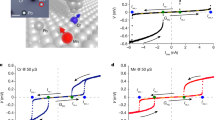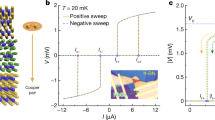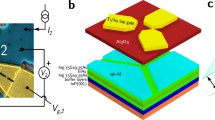Abstract
Many superconducting systems with broken time-reversal and inversion symmetry show a superconducting diode effect, a non-reciprocal phenomenon analogous to semiconducting p–n-junction diodes. While the superconducting diode effect lays the foundation for realizing ultralow dissipative circuits, Josephson-phenomena-based diode effect (JDE) can enable the realization of protected qubits. The superconducting diode effect and JDE reported thus far are at low temperatures (~4 K), limiting their applications. Here we demonstrate JDE persisting up to 77 K using an artificial Josephson junction of twisted layers of Bi2Sr2CaCu2O8+δ. JDE manifests as an asymmetry in the magnitude and distributions of switching currents, attaining the maximum at 45° twist. The asymmetry is induced by and tunable with a very small magnetic field applied perpendicular to the junction and arises due to interaction between Josephson and Abrikosov vortices. We report a large asymmetry of 60% at 20 K. Our results provide a path towards realizing superconducting Josephson circuits at liquid-nitrogen temperature.
This is a preview of subscription content, access via your institution
Access options
Access Nature and 54 other Nature Portfolio journals
Get Nature+, our best-value online-access subscription
$29.99 / 30 days
cancel any time
Subscribe to this journal
Receive 12 print issues and online access
$259.00 per year
only $21.58 per issue
Buy this article
- Purchase on Springer Link
- Instant access to full article PDF
Prices may be subject to local taxes which are calculated during checkout





Similar content being viewed by others
Data availability
Source data are provided with this paper. The experimental data used in the figures of the main text are available via Zenodo at https://zenodo.org/record/8267789. Additional data supporting the findings of this study are available from the corresponding authors upon reasonable request.
References
Tokura, Y. & Nagaosa, N. Nonreciprocal responses from non-centrosymmetric quantum materials. Nat. Commun. 9, 3740 (2018).
Hu, J., Wu, C. & Dai, X. Proposed design of a Josephson diode. Phys. Rev. Lett. 99, 067004 (2007).
Chen, C.-Z. et al. Asymmetric Josephson effect in inversion symmetry breaking topological materials. Phys. Rev. B 98, 075430 (2018).
Misaki, K. & Nagaosa, N. Theory of the nonreciprocal Josephson effect. Phys. Rev. B 103, 245302 (2021).
Ando, F. et al. Observation of superconducting diode effect. Nature 584, 373–376 (2020).
Zhang, E. et al. Nonreciprocal superconducting NbSe2 antenna. Nat. Commun. 11, 5634 (2020).
Wakatsuki, R. et al. Nonreciprocal charge transport in noncentrosymmetric superconductors. Sci. Adv. 3, e1602390 (2017).
Baumgartner, C. et al. Supercurrent rectification and magnetochiral effects in symmetric Josephson junctions. Nat. Nanotechnol. 17, 39–44 (2022).
Lyu, Y.-Y. et al. Superconducting diode effect via conformal-mapped nanoholes. Nat. Commun. 12, 2703 (2021).
Bauriedl, L. et al. Supercurrent diode effect and magnetochiral anisotropy in few-layer NbSe2. Nat. Commun. 13, 4266 (2022).
Narita, H. et al. Field-free superconducting diode effect in noncentrosymmetric superconductor/ferromagnet multilayers. Nat. Nanotechnol. 17, 823–828 (2022).
Wu, H. et al. The field-free Josephson diode in a van der Waals heterostructure. Nature 604, 653–656 (2022).
Trahms, M. et al. Diode effect in Josephson junctions with a single magnetic atom. Nature 615, 628–633 (2023).
Lin, J.-X. et al. Zero-field superconducting diode effect in small-twist-angle trilayer graphene. Nat. Phys. 18, 1221–1227 (2022).
Yuan, N. F. Q. & Fu, L. Supercurrent diode effect and finite-momentum superconductors. Proc. Natl Acad. Sci. USA 119, e2119548119 (2022).
Daido, A., Ikeda, Y. & Yanase, Y. Intrinsic superconducting diode effect. Phys. Rev. Lett. 128, 037001 (2022).
Davydova, M., Prembabu, S. & Fu, L. Universal Josephson diode effect. Sci. Adv. 8, eabo0309 (2022).
Zhang, Y., Gu, Y., Li, P., Hu, J. & Jiang, K. General theory of Josephson diodes. Phys. Rev. X 12, 041013 (2022).
Tanaka, Y., Lu, B. & Nagaosa, N. Theory of giant diode effect in d-wave superconductor junctions on the surface of a topological insulator. Phys. Rev. B 106, 214524 (2022).
Liao, M. et al. Superconductor-insulator transitions in exfoliated Bi2Sr2CaCu2O8+δ flakes. Nano Lett. 18, 5660–5665 (2018).
Sterpetti, E., Biscaras, J., Erb, A. & Shukla, A. Comprehensive phase diagram of two-dimensional space charge doped Bi2Sr2CaCu2O8+x. Nat. Commun. 8, 2060 (2017).
Zhao, S. F. et al. Sign-reversing Hall effect in atomically thin high-temperature Bi2.1Sr1.9CaCu2.0O8+δ superconductors. Phys. Rev. Lett. 122, 247001 (2019).
Ghosh, S. et al. On-demand local modification of high-Tc superconductivity in few unit-cell thick Bi2Sr2CaCu2O8+δ. Adv. Mater. 32, 2002220 (2020).
Yu, Y. et al. High-temperature superconductivity in monolayer Bi2Sr2CaCu2O8+δ. Nature 575, 156–163 (2019).
Can, O. et al. High-temperature topological superconductivity in twisted double-layer copper oxides. Nat. Phys. 17, 519–524 (2021).
Kleiner, R., Steinmeyer, F., Kunkel, G. & Müller, P. Intrinsic Josephson effects in Bi2Sr2CaCu2O8 single crystals. Phys. Rev. Lett. 68, 2394–2397 (1992).
Lee, J. et al. Twisted van der Waals Josephson junction based on a high-Tc superconductor. Nano Lett. 21, 10469–10477 (2021).
Zhao, S. Y. F. et al. Time-reversal symmetry breaking superconductivity between twisted cuprate superconductors. Science 382, 1422–1427 (2023).
Zhu, Y. et al. Persistent Josephson tunneling between Bi2Sr2CaCu2O8+x flakes twisted by 45° across the superconducting dome. Phys. Rev. B 108, 174508 (2023).
Fulton, T. A. & Dunkleberger, L. N. Lifetime of the zero-voltage state in Josephson tunnel junctions. Phys. Rev. B 9, 4760–4768 (1974).
Zhu, Y. et al. Presence of s-wave pairing in Josephson junctions made of twisted ultrathin Bi2Sr2CaCu2O8+x flakes. Phys. Rev. X 11, 031011 (2021).
McElroy, K. et al. Atomic-scale sources and mechanism of nanoscale electronic disorder in Bi2Sr2CaCu2O8+δ. Science 309, 1048–1052 (2005).
Steiner, J. F., Melischek, L., Trahms, M., Franke, K. J. & von Oppen, F. Diode effects in current-biased Josephson junctions. Phys. Rev. Lett. 130, 177002 (2023).
Blatter, G., Feigel’man, M. V., Geshkenbein, V. B., Larkin, A. I. & Vinokur, V. M. Vortices in high-temperature superconductors. Rev. Mod. Phys. 66, 1125–1388 (1994).
Grigorenko, A., Bending, S., Tamegai, T., Ooi, S. & Henini, M. A one-dimensional chain state of vortex matter. Nature 414, 728–731 (2001).
Cole, D. et al. Ratchet without spatial asymmetry for controlling the motion of magnetic flux quanta using time-asymmetric drives. Nat. Mater. 5, 305–311 (2006).
Mros, N., Krasnov, V. M., Yurgens, A., Winkler, D. & Claeson, T. Multiple-valued c-axis critical current and phase locking in Bi2Sr2CaCu2O8+δ single crystals. Phys. Rev. B 57, R8135–R8138 (1998).
Hou, Y. et al. Ubiquitous superconducting diode effect in superconductor thin films. Phys. Rev. Lett. 131, 027001 (2023).
Vodolazov, D. Y. & Peeters, F. M. Superconducting rectifier based on the asymmetric surface barrier effect. Phys. Rev. B 72, 172508 (2005).
Sivakov, A. G., Turutanov, O. G., Kolinko, A. E. & Pokhila, A. S. Spatial characterization of the edge barrier in wide superconducting films. Low Temp. Phys. 44, 226–232 (2018).
Suri, D. et al. Non-reciprocity of vortex-limited critical current in conventional superconducting micro-bridges. Appl. Phys. Lett. 121, 102601 (2022).
Golod, T. & Krasnov, V. M. Demonstration of a superconducting diode-with-memory, operational at zero magnetic field with switchable nonreciprocity. Nat. Commun. 13, 3658 (2022).
Lee, Y. et al. Encapsulating high-temperature superconducting twisted van der Waals heterostructures blocks detrimental effects of disorder. Adv. Mater. 35, 2209135 (2023).
Schrade, C., Marcus, C. M. & Gyenis, A. Protected hybrid superconducting qubit in an array of gate-tunable Josephson interferometers. PRX Quantum 3, 030303 (2022).
Frattini, N. E. et al. 3-wave mixing Josephson dipole element. Appl. Phys. Lett. 110, 222603 (2017).
Brosco, V., Serpico, G., Vinokur, V., Poccia, N. & Vool, U. Superconducting qubit based on twisted cuprate van der Waals heterostructures. Phys. Rev. Lett. 132, 017003 (2024).
Patel, H., Pathak, V., Can, O., Potter, A. C. & Franz, M. d-mon: a transmon with strong anharmonicity based on planar c-axis tunneling junction between d-wave and s-wave superconductors. Phys. Rev. Lett. 132, 017002 (2024).
Li, Q. et al. Bi2Sr2CaCu2O8+δ bicrystal c-axis twist Josephson junctions: a new phase-sensitive test of order parameter symmetry. Phys. Rev. Lett. 83, 4160–4163 (1999).
Takano, Y. et al. d-like symmetry of the order parameter and intrinsic Josephson effects in Bi2Sr2CaCu2O8+δ cross-whisker junctions. Phys. Rev. B 65, 140513 (2002).
Shen, Z. X. et al. Anomalously large gap anisotropy in the a-b plane of Bi2Sr2CaCu2O8+x. Phys. Rev. Lett. 70, 1553–1556 (1993).
Gu, Q. et al. Directly visualizing the sign change of d-wave superconducting gap in Bi2Sr2CaCu2O8+δ by phase-referenced quasiparticle interference. Nat. Commun. 10, 1603 (2019).
Acknowledgements
We thank E. Zeldov, A. Pasupathy, V. Singh, P. Raychaudhuri, S. Banerjee, S. Gueron, H. Bouchiat, R. Vijay, V. Krasnov, S. Sinha and J. Sarkar for helpful discussions and comments. We thank K. Agarwal and N. Bhatia for their assistance in device fabrication. We thank A. P. Shah for his help in making the SiN membranes for shadow masks. We acknowledge the Department of Science and Technology (DST), Nanomission grant SR/NM/NS-45/2016, CORE grant CRG/2020/003836 and Department of Atomic Energy (DAE) of the Government of India (12-R&D-TFR-5.10-0100) for support. Work in Berlin was supported by the Deutsche Forschungsgemeinschaft (DFG, German Research Foundation) through CRC 183 (project C02) as well as TWISTGRAPH.
Author information
Authors and Affiliations
Contributions
S.G. and V.P. fabricated the devices. A.B., K. and A.D. helped in the device fabrication. S.G. and A.B. performed the measurements. D.A.J., R.K. and A.T. grew the BSCCO crystals. J.F.S. and F.v.O. developed the theoretical interpretation. S.G., F.v.O. and M.M.D. wrote the paper. All authors provided input on the paper. M.M.D. supervised the project.
Corresponding authors
Ethics declarations
Competing interests
The authors declare no competing interests.
Peer review
Peer review information
Nature Materials thanks the anonymous reviewers for their contribution to the peer review of this work.
Additional information
Publisher’s note Springer Nature remains neutral with regard to jurisdictional claims in published maps and institutional affiliations.
Extended data
Extended Data Fig. 1 Modulation of switching current with twist angle.
(a) Cross- sectional schematic of twisted BSCCO junction. (b) Equivalent picture of the junction, marked by the dashed rectangle in (a). In the bulk of each BSCCO flake, there are series of intrinsic Josephson junctions (IJJs). At the twisted interface of two BSCCO flakes, an artificial Josephson junction (AJJ) is formed. (c), (d) dc I - V characteristics of 0° and 45° twisted junction at 12 K, and 10 K, respectively. Current in the x-axis is normalized with the area (A) of the junctions to get current densities (J). The magenta-shaded region originates at the interface due to AJJ, while the brown-shaded area is the contribution of IJJs coming from bulk. The switching current density of 45° device is suppressed by a factor of 20 compared to 0° twisted device.
Extended Data Fig. 2 dc I - V characteristic at 60% asymmetry value.
dc I - V charracteristic of the 45° twisted device (D1) at 20 K and at B = –10 μT showing ~ 60% asymmetry. The arrows are for two directions of bias current sweep. Figure S4 in Supplementary Information shows the detailed magnetic field dependent dc I - V characteristics at 20 K of the same device.
Extended Data Fig. 3 Negligible current asymmetry in pristine BSCCO.
(a) Schematic of the measurement scheme. Current is sourced and collected with electrodes 1 and 6. Voltage drop across BSCCO is measured with electrodes 2 and 3. (b) I - V characteristic across pristine BSCCO at 60 K. Negative bias switching branch is flipped to compare it with the positive bias switching branch. The dashed horizontal line ( ± 0.25 mV) indicates the triggering voltage used for obtaining switching currents with the help of a counter. (c) Switching current asymmetry for positive and negative bias with B, applied perpendicular to the device plane. Asymmetry across BSCCO is very small. (d), (e), (f) Distributions of switching currents (\({I}_{{{{\rm{s}}}}}^{+}\) and \({I}_{{{{\rm{s}}}}}^{-}\)) at three different magnetic fields (marked by hexagon, square and star in (c)), –12, 4.1, and 7 μT. Additionally we performed a second control experiment in pristine BSCCO where we restrict the bias current to flow only in the pristine BSCCO and not through the junction. The result is consistent (see Supplementary Information Fig. S14) and the asymmetry we observe is still very small (< 1 %).
Extended Data Fig. 4 Negligible current asymmetry in intrinsic Josephson junction (IJJ).
(a) Schematic of the measurement scheme. (b) I-V characteristic across the junction at 60 K. The different colored curves are for positive and negative switching branches. AJJ switches at a smaller bias current, marked by a magenta dashed rectangle. IIJ switches at a higher bias current, marked by the brown dashed rectangle. (c) Asymmetry between positive (\({I}_{{{{\rm{s}}}}}^{+}\)) and negative (\({I}_{{{{\rm{s}}}}}^{-}\)) switching currents with B. At each B, 100 switching events were recorded and averaged to get \({I}_{{{{\rm{s}}}}}^{+}\) and \({I}_{{{{\rm{s}}}}}^{-}\). A trigger voltage of ± 3.6 mV was used to get switching currents for IJJ. (d), (e), (f) Distributions of switching currents (\({I}_{{{{\rm{s}}}}}^{+}\) and \({I}_{{{{\rm{s}}}}}^{-}\)) at three different magnetic fields (marked by hexagon, square and star in (c)), –36, 4.1, and 44.5 μT.
Extended Data Fig. 5 Josephson diode behavior of 22° twisted (D5) BSCCO Josephson junction.
(a) Optical micrograph image of 22° twisted BSCCO JJ. The scale bar is 20 μm. (b) dc I - V characteristic of the junction at 50.4 K and at B = –0.78 mT. The two curves are for the up and down sweep of bias current. (c) Absolute values of I and V are plotted to clearly see the asymmetry. Here \(| {I}_{{{{\rm{s}}}}}^{-}|\) is larger than \({I}_{{{{\rm{s}}}}}^{+}\). (d) Variation of asymmetry factor α (defined in the text) with B at 50.4 K. B is applied perpendicular to the junction plane. For each B value, 100 switching events were recorded and averaged to get \({I}_{{{{\rm{s}}}}}^{+}\) and \({I}_{{{{\rm{s}}}}}^{-}\). A trigger voltage of ± 0.2 mV was used to get switching currents. The α is calculated from the average values of \({I}_{{{{\rm{s}}}}}^{+}\) and \({I}_{{{{\rm{s}}}}}^{-}\). Although α of the 22° device varies with B qualitatively like the 45° and 0° devices, there are more complex details to it. The measurement has been done in cryogenic setup 2 with a superconducting magnet. An offset value of 1 mT has been subtracted due to the trapped flux in the superconducting magnet (see Supplementary Information, section S13 for details). (e),(f) Half-wave rectification response of the junction at 50.4 K for two different B values. (g),(h), (i), and (j) Distributions of the switching currents (\({I}_{{{{\rm{s}}}}}^{+}\) and \({I}_{{{{\rm{s}}}}}^{-}\)) at different B values. 104 switching events were recorded to get the histograms.
Extended Data Fig. 6 Temperature and twist angle dependent asymmetry.
We have measured multiple devices at three specific twist angles (0°, 22° and 45°). (a) shows the temperature dependence of maximum switching current asymmetry value for devices with different twist angles. For all the devices, the asymmetry increases at lower temperatures. We do not have data points at lower temperatures for all the devices with 0° twist angle; this is mainly to avoid damage to the devices because of large switching currents at lower temperatures (switching current is strongly dependent on twist angle). (b) shows twist angle dependence of asymmetry value at 60 K. The asymmetry value is maximum for 45° twisted devices and decreases with a decrease in twist angle.
Supplementary information
Supplementary Information
Supplementary Sections 1–23, Figs. 1–22, Tables I and II and discussions.
Source data
Source Data Fig. 1
Josephson diode effect in a 45°-twisted BSCCO JJ.
Source Data Fig. 2
Magnetic-field- and temperature-dependent switching current asymmetry data for a 45°-twisted BSCCO JJ.
Source Data Fig. 3
Data for the rectification response of the Josephson diode effect in a 45°-twisted BSCCO.
Source Data Fig. 4
Data of the Josephson diode behaviour of a 0°-twisted device.
Source Data Extended Data Fig. 1
Twist-angle-dependent switching current data.
Source Data Extended Data Fig. 2
Data of the d.c. I–V characteristics showing a 60% switching current asymmetry value.
Source Data Extended Data Fig. 3
Data of the control experiment showing negligible switching current asymmetry in a pristine BSCCO flake.
Source Data Extended Data Fig. 4
Data of the control experiment showing negligible switching current asymmetry in an IJJ.
Source Data Extended Data Fig. 5
Data of the Josephson diode behaviour for a 22°-twisted device.
Source Data Extended Data Fig. 6
Temperature- and twist-angle-dependent switching current asymmetry data.
Rights and permissions
Springer Nature or its licensor (e.g. a society or other partner) holds exclusive rights to this article under a publishing agreement with the author(s) or other rightsholder(s); author self-archiving of the accepted manuscript version of this article is solely governed by the terms of such publishing agreement and applicable law.
About this article
Cite this article
Ghosh, S., Patil, V., Basu, A. et al. High-temperature Josephson diode. Nat. Mater. (2024). https://doi.org/10.1038/s41563-024-01804-4
Received:
Accepted:
Published:
DOI: https://doi.org/10.1038/s41563-024-01804-4



